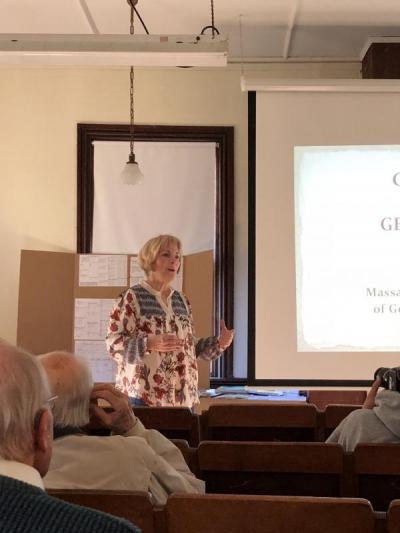7 Tips for researching your family's past
Kathleen Rubano’s passion for genealogy has led her to become the president of the Massachusetts Society of Genealogists' Bristol Chapter, and she’s ready to share her tips on family history research to those interested in trying it out.
Speaking at a Dartmouth Historical and Arts Society presentation on November 19, she offered her suggestions for newbies looking to learn about their past. Here are some of her top tips.
1. Get your ducks in a row.
Before starting a quest to document one’s family line, the first thing budding genealogists should do is collect everything they can get their hands on from their family’s past and sort through it.
That includes typical family heirlooms like old photo albums, yearbooks, diaries and journals, and certificates - like birth, baptism, school, marriage, military, or professional certifications. That can also include less known items like bibles, legal documents, military discharge forms, medical records, and other paper records with vital information on them.
2. Get organized.
Organization is key, as even beginner genealogists can amass stacks of documents and paperwork that must be meticulously sorted and cataloged for easy reference.
“When I started this I only started with one side of my family, and I have boxes upon boxes of stuff,” Rubano said.
Rubano recommends setting up a dedicated area to work on family history, like an office desk or kitchen table. Information should be neatly filed away - Rubano recommends binders for easy swapping - or stored electronically on a computer for easy searching.
3. Start with what you do know, and work from there.
With family information readily accessible, Rubano recommends to start by charting out information already known, starting with closest relatives and working outwards. This will oftentimes leave large gaps that need filling. For that, the first place to turn is living relatives.
“Contact your relatives, especially elderly relatives right away and set up a time you can get together,” Rubano said. She recommends always asking relatives for names, addresses, and dates of people they reference, and try to get names of distant cousins to contact later.
4. Document everything.
Much like a high school research paper, every piece of new information obtained should be thoroughly documented and cited for future reference. This allows quick follow-ups of any inconsistencies between documents, and points back to evidence to back up family information.
“You have to question the accuracy of every document,” Rubano said. “There’s a lot of mistakes and inaccuracies.”
Documenting the source of each piece of evidence also helps to eliminate redundancies which can be costly, like paying for copies of the same vital records from a state records agency.
5. Know what to look for...
Many historical documents, media articles, and even personal items can be valuable to tracing one’s family history. In a basic form, vital information should include the birth, marriage, and date of death information, but other data can provide a more complete picture of a distant relative’s life. That could include everything from church records to census data to employment and occupational forms. Newspapers, government records, court documents, and land records can also provide a wealth of information about a long-lost relative.
6. ... and where to find it.
Rubano cautions against relying solely on computer databases and what can be found already on ancestry services. Instead, she recommends starting off on a small scale.
“Always start locally if you can,” Rubano said. “Start there first and work your way out.”
Local historical societies, government records holders like town clerks and vital records offices, church offices, and libraries are all valuable sources of locally obtained information. Many are always willing to help, Rubano said.
7. Take advantage of free services to start off.
There are many pricy electronic services that offer access to databases, storage of collected information, and sharing of trees, but Rubano recommends those just starting out to check out free services.
Free online services include Free Ancestry For Free, Roots Web, and Family Search. Many local libraries also offer access to records and computer software free of charge. Some even have dedicated genealogy rooms, although they may require advance notice to use.














